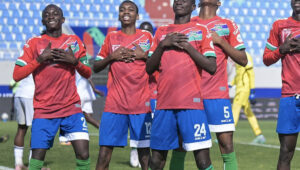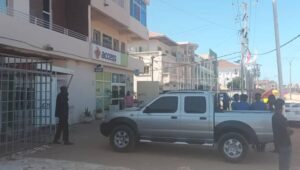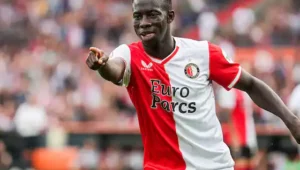On 21 July 1994, a U.S navy ship the USS La Moure County docked in Banjul to conduct a joint training exercise with the Gambia National Army (GNA) the next day. This was broadcast on the radio stations informing the Gambian public of a visible military presence in and around the Greater Banjul Area and that they should not be alarmed.
The coup plotters, including then Lieutenant Jammeh, seized that opportunity to execute a bloodless coup. They had unrestricted access to the armoury and personnel which meant they had the resources to takeover the reigns of power with little or no resistance.
At 7.30am on 22 July 1994, the coup plotters took over Yundum Barracks, a military installation, 15 miles away from Banjul, the capital and the seat of government. The coup was spontaneous and leaderless as the soldiers comprising of junior and non-commission officers mutinied over ‘appalling’ pay and working conditions. They commandeered vehicles and headed for another military installation at Fajara Barracks. When they took over that Barracks and swelled their ranks, an opportunity to stage a coup and seized power became real. The disgruntled soldiers stood control of the airport, radio stations and a power station. The loyalists forces of the Jawara government were overpowered by a well armed and battle-ready group of soldiers at Denton Bridge, where the loyalists were hoping to make a last ditch attempt to quell the coup.
When Jawara realised that Denton Bridge had felled, he sought refuge at the US navy ship La Moure County which was docked at the Banjul Port. Jawara asked the Americans for protection and military intervention to put down the coup.
Former army captain Mamat Cham during his testimony to The Gambia’s Truth, Reconciliation and Reparations Commission on Thursday gave a fascinating insider account of the meetings and negotiations with the commander of the US navy ship, President Jawara and the Senegalese president, Abdou Diouf.
Cham said the commander of the La Moure County was received at the State House by the junta leaders during the negotiation to end the impasse.
“His message was that the American government had asked him to negotiate President Jawara’s safe return and for him to take back control of his presidency. We told him that was unacceptable to the junta and that Jawara would only be allowed back in a different capacity as an elder statesman.”
The US navy commander didn’t seemed to like the tough stance of the junta leaders during the meeting and it ended in a stalemate. The commander, according to Capt Cham, issued direct threat of intervention to the junta leaders at State House.
Cham said: “The discussion didn’t go well because of some threats made by the U.S naval commander. During the discussion, he stood up and said: ‘If I want I can f****** put a stop to this nonsense.’
“We told him firmly that was outside the diplomatic protocols that existed between civilised nations. His presence in the country was based on a military agreement we had with the U.S and excluded him as an individual or anyone else from intervening in the domestic affairs of another sovereign state.
“That was the end of the negotiations with the U.S commander and crew of the La Moure County. Edward Singhateh was asked to negotiate directly with President Jawara who was on board the U.S navy ship.”
The commander and his crew returned to their navy ship awaiting further instructions from Washington. Even though The Gambia was a U.S ally, it was never of strategic interest to the U.S government. But during all these diplomatic negotiations and the issuance of threats by the U.S navy commander, one key major player that would have made intervention possible was Senegal. They had the resources and personnel to put down the coup as they did in 1981 during the Kukoi armed insurrection. When Senegal refused to be dragged into another intervention in Gambian internal affairs, it was apparent that a single U.S navy ship with 39 crew members could not attempt to reverse a coup without the participation of Senegal.
The US ambassador, following talks with his government, told the disappointing Jawara and other officials of his government that the U.S would not be sending marines to suppress the coup.
The USS La Moure County left The Gambia’s territorial waters and sailed to Dakar, Senegal with Jawara, his family and other officials. Senegal offered Jawara and many of his officials refuge.
By Momodou Musa Touray










Recent Comments